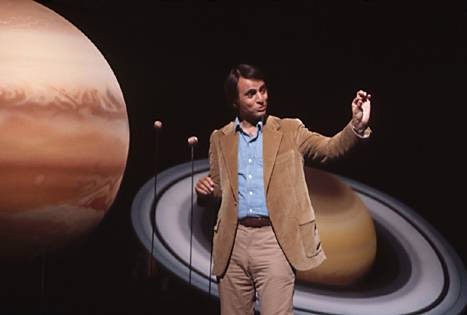Carl Sagan showed us all how inspiring science can be. [8 May 2012 | Peter Boyer]

Master astronomer and science teacher Carl Sagan as he appeared on his 1978 television show “Cosmos”
Flickering black and white reception made it hard to be enthusiastic about television in rural Tasmania in 1982. But for 13 wonderful weeks that winter, I was transfixed by a show about pretty well everything, featuring a cheerful, irrepressible American astronomer named Carl Sagan.
Sagan’s masterly Cosmos, 13 one-hour episodes about life, the universe and everything, was America’s most watched television series of its time. It quickly became a global success, and now rates as the most successful science documentary ever made. Who says science is boring?
A child of poor immigrants with a stock-standard public school education, Sagan was a world-leading astronomer who wrote many highly-regarded scientific papers. But his greatest gift was as a teacher, communicating to the public at large his personal feelings of wonder at the world about him and the importance of sceptical thought in making sense of it all.
Sagan’s reputation would have been secure had Cosmos been his only achievement, but he penned another masterpiece, published in the year of his untimely death in 1996 at the age of 62.
The Demon-Haunted World is a cry to America and the world to protect and strengthen the hard-won system of learning and knowledge that we call science against the ever-present threat of ignorance and superstition. Its subtitle says it all: “Science as a candle in the dark”.
Except for the rise of scientific thought, the 20th century world described by Sagan is a world little different from ages past. It is a world in which pseudoscience constantly presents as a threat because, as Sagan says, it avoids “distracting confrontations with reality”.
Pseudoscience in its modern guise comes in many forms, from UFOs and alien abductions to spoon-bending, astrology, clairvoyance, ghostly visitations and voices from the dead. To some people such things are just a diversion, but to many others they are very real and very serious.
What separates this from real science, said Sagan, is that “the standards of argument, what passes for evidence, are much more relaxed”. Yet many people know nothing of such distinctions — that their belief system may be based on fallacy.
Science has come under attack in large part because, as it sees the world, everything is up for scrutiny and nothing is sacred. “We cannot have science in bits and pieces,” said Sagan, “applying it where we feel safe and ignoring it when we feel threatened.”
Unless we seal our brains into rigidly separated compartments, he asked, “how is it possible to fly in airplanes, listen to the radio or take antibiotics while holding that the Earth is around 10,000 years old or that all Sagittarians are gregarious and affable?” How indeed?
Whatever we might have been taught about observed evidence and the scientific method, and despite the powerful successes of scientific knowledge, the fact is, as Sagan put it, we continue to allow ourselves to be haunted by demons. What’s happening here?
In ignoring the real human needs addressed by pseudoscience, scientists themselves must take some blame. “Scientific scepticism may come across as arrogant, dogmatic, heartless and dismissive of the feelings and deeply held beliefs of others,” said Sagan.
Pseudoscience can’t tell us what we need to know about how and where our food is produced, which medical treatment best meets our need, and more broadly, what’s in store for our planet’s climate and life systems. For all this and much more, we need to be able to discriminate between good and bad information.
These skills are best learned early in our lives, when our brains are in their most critical stages of development. By the time they leave primary school, all our children should have the skill of critical, sceptical thinking — the basis of the scientific method.
I remember my own primary education telling me nothing of what I wanted to know about mountains, clouds, planets and the cosmos. The new Australian schools curriculum, by contrast, is a blueprint for a well-integrated, solidly-based science education from foundation onward.
Having high-quality curricula and support materials are a good start, but it’s another thing altogether to get teachers to use them effectively and to instil into their students something of the wonder and excitement that made Sagan’s Cosmos such an unforgettable experience.
CSIRO provides admirable support for primary science education with an Australia-wide program that includes “Scientists in Schools”, in which scientists have direct contact with school groups, but the program is limited by a diminishing budget and other calls on scientists’ time.
In a program called Primary Connections, the Australian Academy of Science has taken another tack, providing teachers with resources and professional learning to enhance their confidence and competence in encouraging a stronger scientific focus among students.
Primary Connections suffered a big setback with the ending of federal government support late last year, but a $100,000 donation from astronomer and 2011 Nobel laureate Dr Brian Schmidt (the money was part of his prize), has given the program a new lease on life.
AAS President Professor Suzanne Cory said the donation was “an unequivocal and highly symbolic message that supporting science and science education is vital to the nation’s future.”
Schmidt’s exceptional vision and generosity needs to strike a chord among both administrators and teachers, encouraging them to keep a focus on early science education. Nothing is more important.
